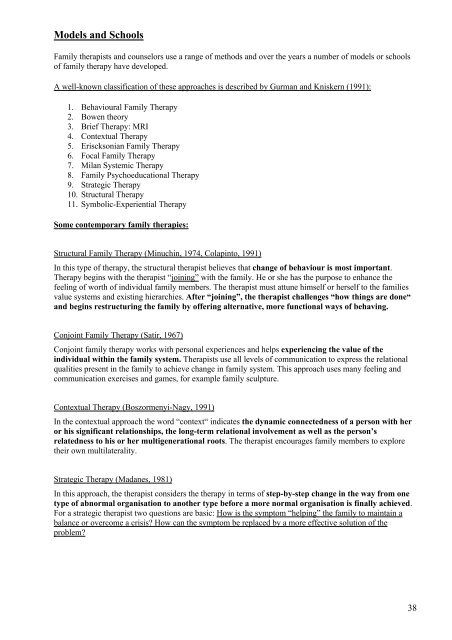FAMILY THERAPY - DEAN AMORY
This is the new, extended and improved version of “An Introduction to Family Therapy”, your reference guide containing detailed information about all important facets of family therapy: schools and methods, strategies used, structure and content of family therapy sessions, stages, basic techniques, influential people, history of family therapy,… Since I feel many people will benefit and appreciate being allowed easy access to this kind of information ordered in short, easily accessible chapters, I decided to make this compilation work - based on information freely available in the public domain -, available for free to everybody as a download file. ----//---- The cover illustration is from Zirta from Mexico: www.zirta.net - email address: beatriz@zirta.net
This is the new, extended and improved version of “An Introduction to Family Therapy”, your reference guide containing detailed information about all important facets of family therapy: schools and methods, strategies used, structure and content of family therapy sessions, stages, basic techniques, influential people, history of family therapy,… Since I feel many people will benefit and appreciate being allowed easy access to this kind of information ordered in short, easily accessible chapters, I decided to make this compilation work - based on information freely available in the public domain -, available for free to everybody as a download file.
----//----
The cover illustration is from Zirta from Mexico: www.zirta.net - email address: beatriz@zirta.net
You also want an ePaper? Increase the reach of your titles
YUMPU automatically turns print PDFs into web optimized ePapers that Google loves.
Models and Schools<br />
Family therapists and counselors use a range of methods and over the years a number of models or schools<br />
of family therapy have developed.<br />
A well-known classification of these approaches is described by Gurman and Kniskern (1991):<br />
1. Behavioural Family Therapy<br />
2. Bowen theory<br />
3. Brief Therapy: MRI<br />
4. Contextual Therapy<br />
5. Eriscksonian Family Therapy<br />
6. Focal Family Therapy<br />
7. Milan Systemic Therapy<br />
8. Family Psychoeducational Therapy<br />
9. Strategic Therapy<br />
10. Structural Therapy<br />
11. Symbolic-Experiential Therapy<br />
Some contemporary family therapies:<br />
Structural Family Therapy (Minuchin, 1974, Colapinto, 1991)<br />
In this type of therapy, the structural therapist believes that change of behaviour is most important.<br />
Therapy begins with the therapist “joining” with the family. He or she has the purpose to enhance the<br />
feeling of worth of individual family members. The therapist must attune himself or herself to the families<br />
value systems and existing hierarchies. After “joining”, the therapist challenges “how things are done“<br />
and begins restructuring the family by offering alternative, more functional ways of behaving.<br />
Conjoint Family Therapy (Satir, 1967)<br />
Conjoint family therapy works with personal experiences and helps experiencing the value of the<br />
individual within the family system. Therapists use all levels of communication to express the relational<br />
qualities present in the family to achieve change in family system. This approach uses many feeling and<br />
communication exercises and games, for example family sculpture.<br />
Contextual Therapy (Boszormenyi-Nagy, 1991)<br />
In the contextual approach the word “context“ indicates the dynamic connectedness of a person with her<br />
or his significant relationships, the long-term relational involvement as well as the person’s<br />
relatedness to his or her multigenerational roots. The therapist encourages family members to explore<br />
their own multilaterality.<br />
Strategic Therapy (Madanes, 1981)<br />
In this approach, the therapist considers the therapy in terms of step-by-step change in the way from one<br />
type of abnormal organisation to another type before a more normal organisation is finally achieved.<br />
For a strategic therapist two questions are basic: How is the symptom “helping” the family to maintain a<br />
balance or overcome a crisis? How can the symptom be replaced by a more effective solution of the<br />
problem?<br />
38


















